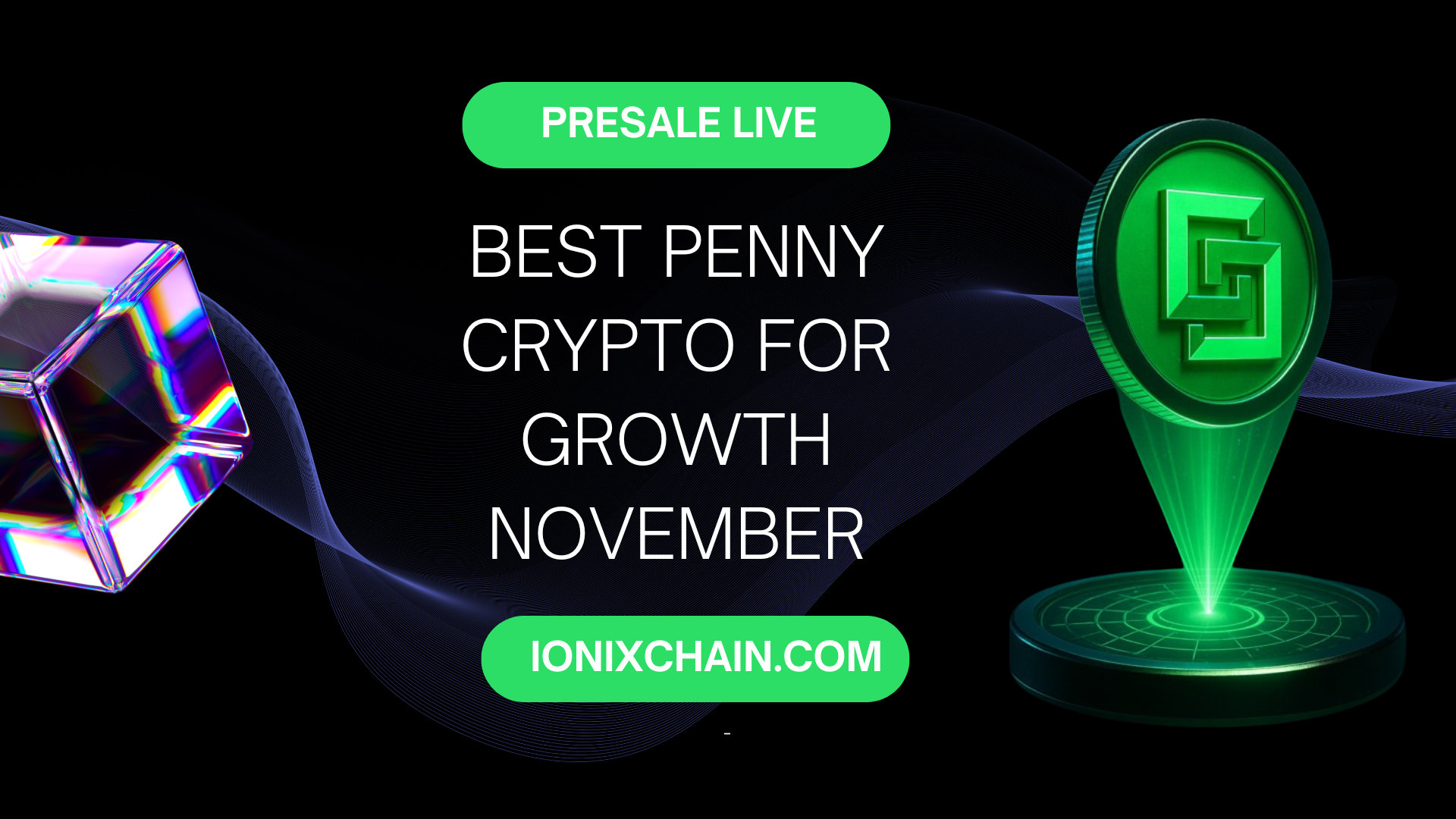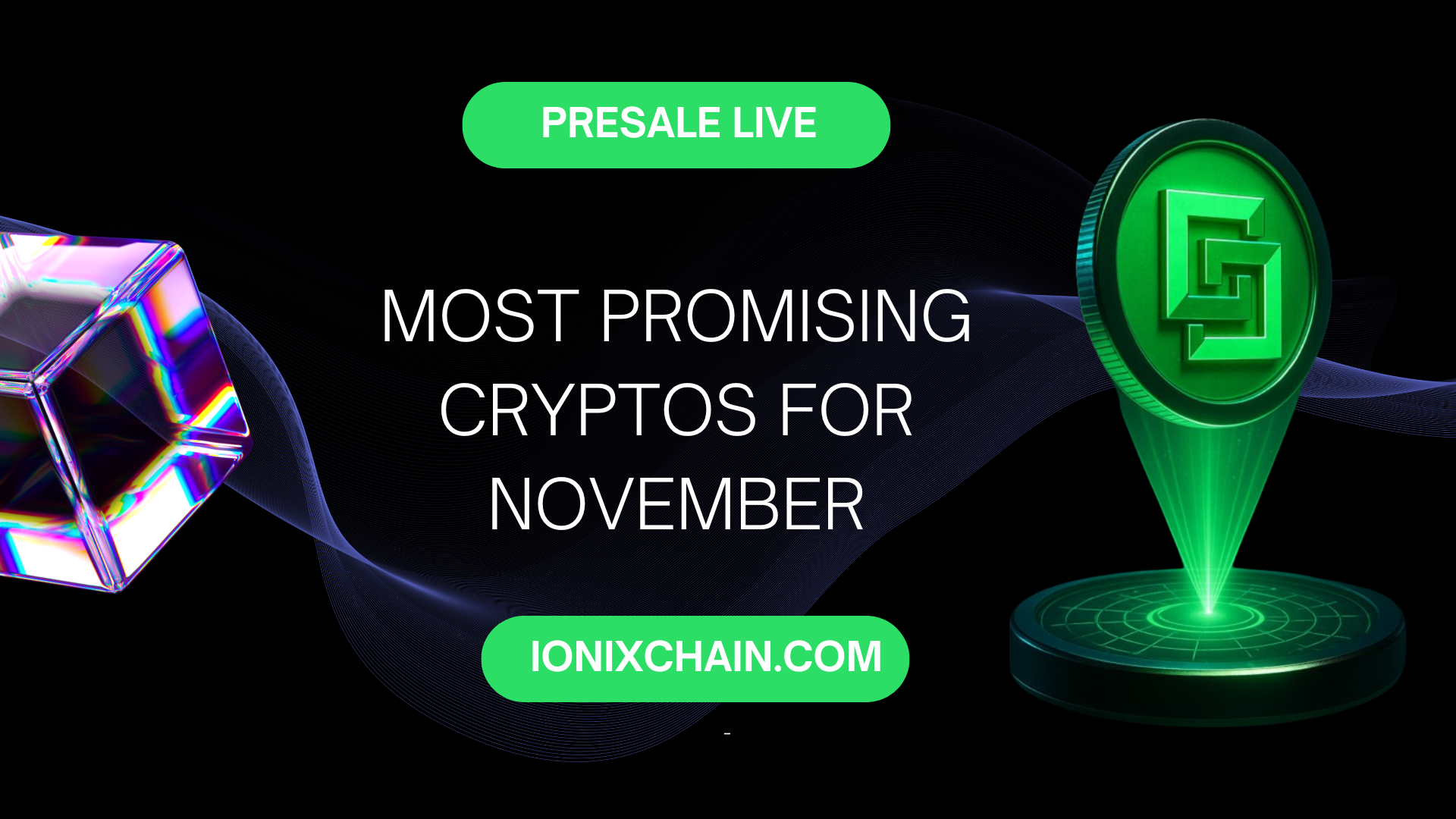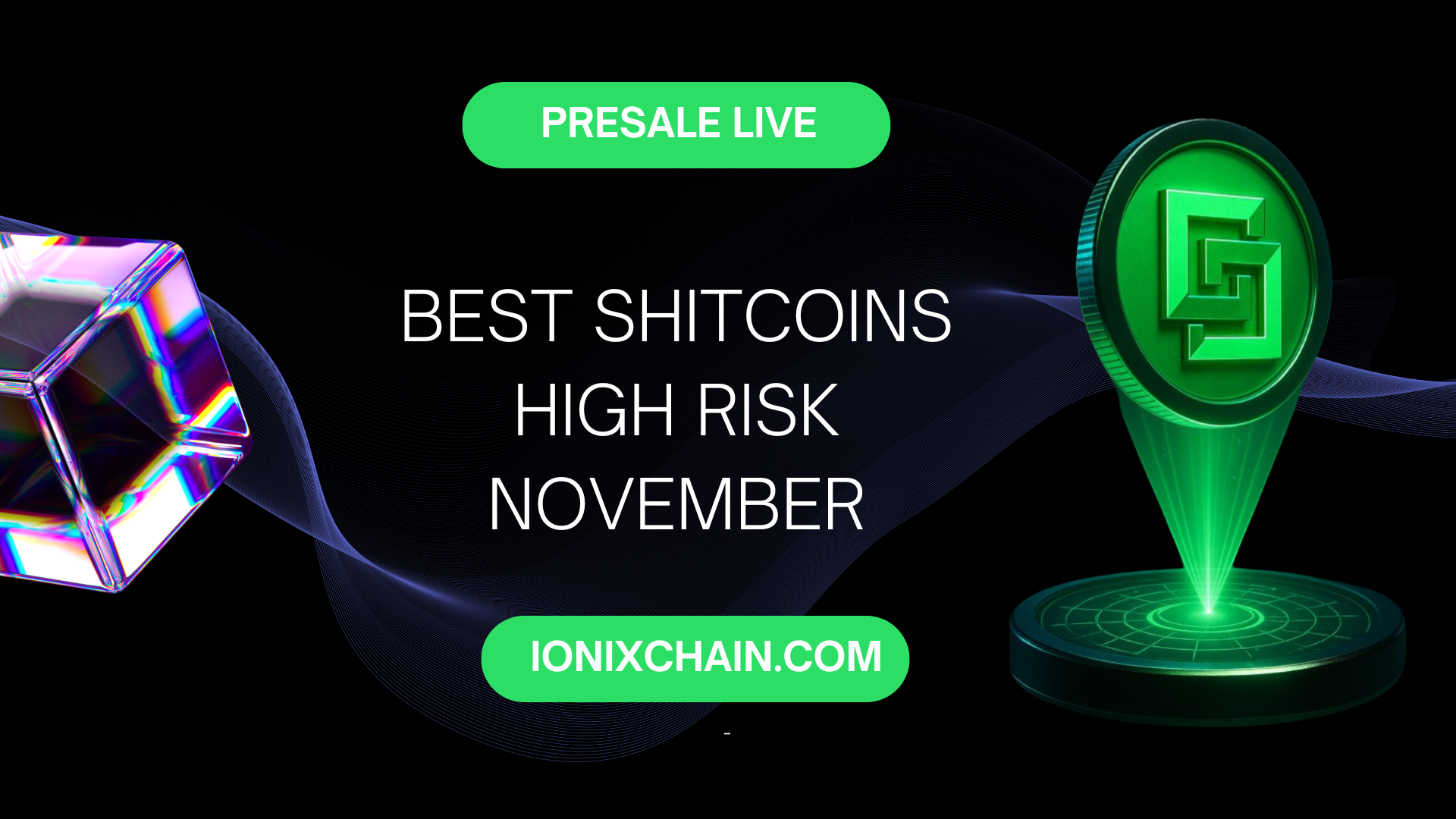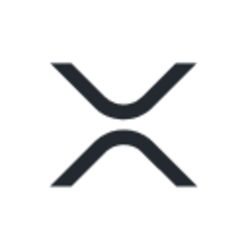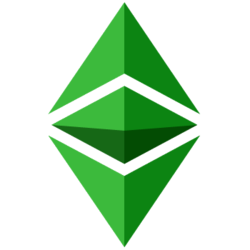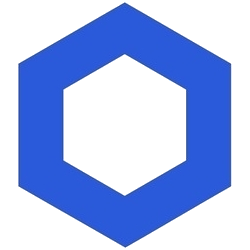Coin Launch Space is here to give you clear, accurate, and trustworthy information about crypto. Our team is made up of experts with real experience in crypto, finance, and new tech. Every article and page we publish is carefully reviewed by skilled editors to make sure it’s up to our high standards. We take pride in offering honest, easy-to-understand reviews based on real knowledge. Check out our editorial policy and see how we test and review crypto assets.
The cryptocurrency landscape in 2025 continues to evolve with increasing sophistication, as investors seek projects that combine technological innovation with genuine utility and substantial growth potential. Among the numerous blockchain initiatives emerging this year, IONIX CHAIN ($IONX) has positioned itself as a compelling best penny crypto investment opportunity, attracting attention from both retail investors and industry analysts for its ambitious integration of artificial intelligence with blockchain infrastructure.
IONIX CHAIN represents what the project describes as the world’s first AI-powered Layer 1 blockchain, built on a proprietary Quantum AI Consensus mechanism designed to address fundamental limitations that have constrained earlier blockchain generations. The project’s presale is currently active, offering early-stage investors access to $IONX tokens at prices significantly below projected exchange listing valuations, creating a potential entry point for those seeking exposure to emerging blockchain technology.
As traditional cryptocurrency giants experience market fluctuations throughout 2025, IONIX CHAIN has emerged as an alternative investment vehicle that appeals to investors searching for the best penny crypto opportunities with higher risk-reward profiles. The project’s technical specifications, combined with its unique tokenomics and revenue-sharing model, warrant comprehensive examination for anyone considering participation in the cryptocurrency presale market.
Project Background and Vision: Understanding IONIX CHAIN’s Foundation
Genesis and Development Timeline
IONIX CHAIN’s development began in Q1 2025 with the creation of its foundational Quantum AI Consensus protocol and the assembly of a global team spanning multiple jurisdictions. According to available project information, the development team completed the blockchain prototype and finalized the technical whitepaper during this initial phase, establishing the architectural framework for what would become the platform’s core technological differentiator.
By Q2 2025, the project had transitioned from development to community building and presale launch, assembling a community exceeding 50,000 participants across various social channels. During this period, IONIX CHAIN reportedly secured security audits from blockchain security firms including Certik and Solid Proof, achieving scores of 90 out of 100 and 85 out of 100 respectively, according to promotional materials. These audits represent important third-party validations of the smart contract infrastructure underlying the presale mechanism.
Leadership and Team Structure
The project identifies a globally distributed leadership team with purported expertise spanning blockchain development, artificial intelligence, marketing strategy, and business development. The stated leadership includes Joel Arterburn as Chief Executive Officer based in the United States, Sophie Müller as Chief Technology Officer in Germany with AI and blockchain specialization, Lucas Tan as Chief Marketing Officer in Singapore, and Elena Petrova as Chief Business Development Officer in Russia focusing on partnership development.
While these biographical details provide context about the project’s organizational structure, independent verification of team credentials and professional backgrounds represents an important due diligence step for potential investors, as is standard practice when evaluating any cryptocurrency investment opportunity or best penny crypto project.
Technology Architecture: Examining IONIX CHAIN’s Blockchain Innovation
Quantum AI Consensus Mechanism
The technological cornerstone of IONIX CHAIN’s value proposition centers on what the project terms Quantum AI Consensus, described as a novel consensus mechanism that integrates artificial intelligence with blockchain validation processes. This approach purportedly combines elements of Proof-of-Stake with Directed Acyclic Graph architecture to achieve performance specifications that substantially exceed those of conventional blockchain networks.
According to project documentation, this consensus mechanism enables the network to process up to 500,000 transactions per second with sub-second finality, representing a significant improvement over first-generation blockchains like Bitcoin (approximately 7 TPS) and even many modern high-performance chains. The AI component of the consensus mechanism reportedly optimizes validator selection, transaction ordering, and network resource allocation in real-time, adapting to changing network conditions dynamically.
Adaptive Smart Contract Infrastructure
IONIX CHAIN’s technical roadmap includes the development of what it describes as Adaptive Smart Contracts, which represent an evolutionary approach to programmable blockchain logic. Unlike traditional smart contracts that execute predetermined code without modification, these adaptive contracts purportedly utilize artificial intelligence to optimize their execution parameters based on network conditions, gas prices, and usage patterns.
This technological approach aims to address common smart contract inefficiencies, including gas optimization, security vulnerability detection, and execution pathway selection. The practical implementation and effectiveness of this technology will become more apparent as the network transitions from testnet to mainnet operations, scheduled for 2026 according to the project roadmap.
Cross-Chain Interoperability Framework
Recognizing the fragmented nature of the current blockchain ecosystem, IONIX CHAIN has implemented cross-chain bridge infrastructure designed to facilitate seamless communication and asset transfers with established networks including Ethereum, Binance Smart Chain, and Solana. This interoperability framework positions $IONX as a settlement currency within a multi-chain architecture, potentially allowing the project to access liquidity and user bases from multiple blockchain ecosystems.
The cross-chain bridges employ security mechanisms including multi-signature validation and AI-powered anomaly detection, which the project claims achieves 99.9% accuracy in identifying irregular transactions and potential security threats. This security layer represents a critical component for any blockchain project seeking to establish credibility as a best penny crypto investment with institutional-grade infrastructure.
IONX Tokenomics: Economic Model and Token Distribution
Total Supply and Allocation Structure
Total Initial Supply: 2,150,000,000 IONX tokens
Public Sale Allocation: 20% (430,000,000 IONX)
Treasury Reserve: 17% (365,500,000 IONX)
Ecosystem Development: 15% (322,500,000 IONX)
Team Allocation: 10% (215,000,000 IONX)
Liquidity Provision: 8% (172,000,000 IONX)
The tokenomics structure allocates a substantial portion of the total supply to public distribution and ecosystem development, which theoretically supports broader community participation and long-term network growth. The 20% public allocation provides significant token availability for presale participants and future exchange trading, while the 17% treasury reserve offers resources for ongoing operational needs, partnerships, and strategic initiatives.
The ecosystem development allocation of 15% represents dedicated resources for developer grants, dApp incentives, and platform growth initiatives. This allocation includes a stated $5 million developer grant pool designed to incentivize third-party developers to build applications on the IONIX CHAIN infrastructure, which could accelerate ecosystem adoption if effectively deployed.
Deflationary Mechanisms and Supply Economics
IONIX CHAIN incorporates deflationary tokenomics through a transaction burn mechanism, whereby a percentage of each network transaction is permanently removed from circulation. This deflationary pressure creates a gradually decreasing supply over time, which economic theory suggests could support upward price momentum assuming consistent or growing demand, making it attractive as a best penny crypto investment with built-in scarcity mechanisms.
The deflationary model contrasts with inflationary token economics employed by some blockchain networks, where new tokens are continuously minted to reward validators and support network operations. While deflationary mechanisms can create favorable supply dynamics, their effectiveness depends heavily on achieving substantial transaction volume and network adoption to generate meaningful burn rates.
Revenue Sharing and Passive Income Model
One of IONIX CHAIN’s distinctive features is its revenue-sharing mechanism, which distributes 15% of daily gas fee revenue to $IONX holders maintaining tokens in non-custodial wallets. This creates a passive income stream tied directly to network utilization, theoretically aligning holder incentives with network growth and creating fundamental value independent of speculative price appreciation.
The revenue-sharing model represents an innovative approach to token utility that differentiates IONIX CHAIN from purely speculative cryptocurrency projects. However, the actual returns generated through this mechanism depend entirely on achieving significant transaction volume on the network, which remains uncertain for a project still in presale stage with mainnet launch scheduled for 2026.
Use Cases and Real-World Applications
Decentralized Finance Applications
IONIX CHAIN positions its infrastructure as particularly suitable for decentralized finance applications, citing AI-driven capabilities including fraud detection, real-time credit scoring, and automated trading systems. The project claims its AI components can achieve 99.9% accuracy in identifying fraudulent transactions and irregular patterns, which would represent a significant security enhancement for DeFi protocols if validated through real-world deployment.
The ultra-low transaction fees of approximately $0.0005 per transaction create favorable economics for DeFi applications that require frequent interactions and microtransactions. This fee structure could theoretically support higher-frequency trading strategies, yield farming operations, and other DeFi activities that become economically unviable on networks with higher gas costs, enhancing IONIX CHAIN’s position as a best penny crypto with practical utility.
Content Monetization and Creator Economy
The platform’s roadmap includes features designed to support content creators through AI-verified transaction transparency and automated royalty distribution systems. This addresses common challenges in digital content monetization, including payment delays, platform fees, and verification of content authenticity and ownership rights.
By leveraging blockchain immutability combined with AI verification, IONIX CHAIN aims to create transparent payment rails for content creators across various media types, including digital art, music, written content, and video. The practical implementation of these features will require significant ecosystem development and creator onboarding, representing both opportunity and execution risk.
Enterprise and Government Applications
IONIX CHAIN identifies potential applications in enterprise environments including supply chain management, healthcare data sharing, and government services such as electronic voting and resource allocation. The project claims its technology can reduce diagnosis times by 30% in healthcare applications and cut logistics costs by up to 25% through predictive analytics.
These enterprise applications represent substantial market opportunities if successfully executed, as they address real-world inefficiencies with measurable economic impact. However, enterprise blockchain adoption historically faces significant barriers including integration complexity, regulatory compliance requirements, and organizational inertia, which IONIX CHAIN will need to navigate successfully to realize these use cases.
Cryptocurrency Presale Structure and Investment Mechanics
Multi-Stage Presale Design
The IONIX CHAIN presale operates through a multi-stage structure with progressively increasing token prices at each stage, designed to reward earlier participants with more favorable entry pricing. The presale began at $0.015 per $IONX in Stage 1 and has progressed to Stage 7 at the current price of $0.037, with Stage 8 scheduled to begin at $0.039 per token.
This tiered pricing structure creates urgency for potential investors while providing clear price discovery mechanisms throughout the fundraising process. The presale has raised over $719,000 toward a total target of $11.775 million, indicating moderate traction in the competitive cryptocurrency presale market where hundreds of projects compete for investor attention and capital.
Bonus Structure and Investment Incentives
Investment Tiers and Bonus Percentages:
$500 – $2,499: 25% extra tokens
$2,500 – $5,499: 30% extra tokens
$5,500 – $10,999: 35% extra tokens
$11,000+: 50% extra tokens
$21,000+: 70% extra tokens
The bonus structure provides substantial incentives for larger investments, with the highest tier offering 70% additional tokens for contributions exceeding $21,000. These bonuses effectively reduce the average cost per token for participants, enhancing potential returns if the project achieves its projected listing prices between $2.00 and $5.00 per $IONX.
Additionally, all presale participants qualify for the Loyalty Airdrop program, which provides up to 5% bonus tokens to early supporters. This combination of immediate bonus tokens and future airdrops creates a multi-layered incentive structure designed to encourage early participation and long-term holding behavior among investors seeking the best penny crypto opportunities.
Participation Process and Technical Requirements
Participating in the IONIX CHAIN presale requires connecting a compatible Web3 wallet such as MetaMask, Trust Wallet, or Phantom through WalletConnect functionality. The presale accepts multiple payment methods including Bitcoin, Ethereum, Solana, USDT on both ERC-20 and BEP-20 networks, and USDC on ERC-20, providing flexibility for investors holding various cryptocurrencies.
The minimum investment threshold is set at $15 USD, making the presale accessible to retail investors with limited capital while still maintaining a barrier sufficient to reduce spam and frivolous participation. Token distribution occurs automatically after presale conclusion, with purchased $IONX and bonus allocations sent directly to participants’ connected wallets.
The smart contract address (0x733fF6DaFed473CD88ee8B1C17B050Cf2865Ea6b) is publicly available for technical verification, allowing sophisticated investors to review the contract code and validate security parameters before participation. This transparency represents important infrastructure for establishing credibility in the cryptocurrency presale market.
Growth Potential Analysis: Why IONIX CHAIN Could Be the Best Penny Crypto in 2025
Market Timing and Cryptocurrency Bull Cycle Alignment
IONIX CHAIN’s presale timing coincides with renewed optimism in cryptocurrency markets following significant price recoveries in major assets. This positive market sentiment creates favorable conditions for alternative cryptocurrency projects, as investors demonstrate increased risk appetite and willingness to allocate capital to emerging tokens with higher growth potential but correspondingly higher risk profiles.
The convergence of artificial intelligence and blockchain technology represents one of the most significant technological narratives in the current investment landscape. IONIX CHAIN positions itself directly at this intersection, potentially benefiting from enthusiasm surrounding both AI advancement and blockchain innovation. This dual narrative appeal could attract investors seeking exposure to transformative technologies through a best penny crypto investment vehicle.
Technical Differentiation and Competitive Positioning
The claimed performance specifications of 500,000 transactions per second with sub-second finality would, if achieved in production environments, position IONIX CHAIN among the highest-performing blockchain networks currently available. This technical capability addresses one of the primary limitations that has constrained blockchain adoption for high-volume applications including payments, gaming, and real-time financial trading.
The integration of AI-driven optimization throughout the network stack represents a novel approach that could provide meaningful advantages in resource allocation, security threat detection, and smart contract efficiency. If these AI capabilities deliver tangible improvements in network performance and security, IONIX CHAIN could differentiate itself in an increasingly crowded Layer 1 blockchain market.
Economic Incentives and Holder Value Proposition
The combination of staking rewards up to 12% APY, revenue sharing from gas fees, and deflationary token burns creates multiple value accrual mechanisms for $IONX holders. This multi-faceted approach to token utility goes beyond simple speculative appreciation, providing tangible economic returns tied to network activity and growth.
For investors seeking the best penny crypto with fundamental value drivers rather than purely speculative appeal, these economic mechanisms represent important considerations. However, the actual returns generated depend entirely on achieving substantial network adoption and transaction volume, which remains uncertain for a project still in presale phase.
Exchange Listing Strategy and Liquidity Development
IONIX CHAIN has stated intentions to list on major centralized and decentralized exchanges following presale completion, with projected listing prices between $2.00 and $5.00 per $IONX. The project mentions confirmed partnerships with Binance and OKX, though independent verification of these partnership details would be prudent for potential investors conducting due diligence.
If exchange listings occur at the projected price range, presale participants would realize returns ranging from 5,305% to 13,413% based on the current Stage 7 price of $0.037. These potential multiples position IONIX CHAIN as a high-risk, high-reward opportunity characteristic of best penny crypto investments in early-stage blockchain projects.
Price Projections and Market Positioning
Short-Term Price Expectations (2025-2026)
Analytical frameworks for cryptocurrency presale valuations typically examine the relationship between presale prices, initial listing prices, and subsequent market performance based on technology strength, community engagement, and overall market conditions. For IONIX CHAIN, the stated listing price range of $2.00 to $5.00 represents the first significant price discovery point where market forces will validate or adjust the project’s valuation.
Historical patterns in cryptocurrency presales suggest successful projects often experience initial appreciation following exchange listings, driven by presale participants who cannot immediately sell (particularly if vesting or lock-up periods apply), new investors gaining access through exchanges, and speculative interest in new listings. However, this initial appreciation frequently gives way to consolidation or correction as early investors take profits and the market establishes sustainable valuation levels.
For IONIX CHAIN specifically, if the mainnet launches successfully in 2026 with functional AI features and growing transaction volume, the token could potentially appreciate toward the $10 to $14 range by end of 2025 or early 2026, representing 5x to 7x returns from the projected listing price. This projection assumes favorable market conditions, successful technology deployment, and achievement of key roadmap milestones.
Medium-Term Growth Trajectory (2026-2027)
The medium-term price trajectory depends heavily on IONIX CHAIN’s ability to transition from promising whitepaper to functioning network with real user adoption. Key factors influencing medium-term valuation include the successful deployment of cross-chain bridges, growth in daily active addresses and transaction volume, integration of major DeFi protocols and dApps on the platform, and delivery of AI-powered features that provide measurable advantages over competing networks.
If IONIX CHAIN achieves meaningful network adoption with sustained transaction volume generating substantial gas fee revenue for holders, analysts suggest the token could trade in a range from $8 to $20 in moderate to bullish market scenarios. This wide range reflects the significant uncertainty inherent in projecting valuations for early-stage blockchain projects, where success depends on numerous technological and market variables.
Long-Term Potential and Market Maturation (2028-2030)
Long-term price potential for any cryptocurrency project depends on its evolution from speculative asset to fundamental infrastructure supporting substantial economic activity. For IONIX CHAIN to achieve sustained appreciation over multi-year time horizons, it must demonstrate actual utility that attracts organic user adoption rather than purely speculative investment flows.
If IONIX CHAIN successfully establishes itself as primary infrastructure for AI-blockchain applications with meaningful enterprise adoption, the project could potentially achieve market capitalizations comparable to established Layer 1 networks. However, such outcomes remain highly speculative and depend on the project navigating numerous technical, competitive, and regulatory challenges over an extended time period.
The decade ahead will be shaped by how effectively artificial intelligence and blockchain technologies continue to converge and create practical applications. IONIX CHAIN’s positioning at this intersection creates potential for substantial long-term appreciation if execution matches ambition, though investors should maintain realistic expectations given the early-stage nature of the project and the high failure rate of blockchain initiatives generally.
Potential Risks and Challenges
Critical Investment Risks to Consider
Presale Stage Uncertainty and Execution Risk
IONIX CHAIN currently exists as a presale-stage project with testnet launch scheduled for late 2025 and mainnet deployment targeted for 2026. This early development stage carries substantial execution risk, as the project has not yet demonstrated its technology functioning at scale in production environments with real economic value at stake.
Many blockchain projects with impressive technical whitepapers and ambitious roadmaps have failed to deliver on their promised capabilities when transitioning from concept to reality. Technical challenges in achieving 500,000 TPS with sub-second finality while maintaining security and decentralization remain substantial, and any delays or technical compromises could significantly impact investor sentiment and token valuation.
Unproven AI Integration at Scale
While the integration of artificial intelligence with blockchain consensus represents an innovative approach, this technology remains largely untested in production blockchain environments at scale. The claimed benefits of AI-driven optimization, including adaptive smart contracts and 99.9% fraud detection accuracy, require validation through real-world deployment before investors can assess their actual effectiveness.
The complexity of combining AI systems with blockchain infrastructure introduces potential vulnerabilities and failure points that may not be apparent until the network experiences significant transaction volume and diverse use cases. Investors should recognize that novel technological approaches carry higher uncertainty compared to proven architectures with extensive operational history.
Regulatory Considerations and Compliance Uncertainty
The cryptocurrency industry globally faces evolving regulatory frameworks that create uncertainty for token projects, particularly those conducting presales and promising investment returns. Different jurisdictions maintain varying approaches to cryptocurrency regulation, and changes in regulatory treatment could impact IONIX CHAIN’s ability to list on exchanges, serve users in certain markets, or maintain its planned economic model.
The revenue-sharing mechanism distributing gas fee proceeds to token holders may face regulatory scrutiny in some jurisdictions where such arrangements could be interpreted as securities offerings requiring specific licenses and compliance frameworks. Potential investors should consider their own jurisdictional regulations and seek appropriate legal advice before participating in cryptocurrency presales.
Market Volatility and Liquidity Risks
Cryptocurrency markets exhibit substantial volatility, with price movements of 20% to 50% occurring regularly even for established assets. New tokens emerging from presales typically experience even greater volatility as price discovery occurs and early investors make trading decisions based on individual risk tolerances and return objectives.
Presale participants should anticipate potentially limited liquidity immediately following exchange listings, particularly if vesting schedules or lock-up periods concentrate selling pressure at specific future dates. The ability to exit positions at desired prices depends on sufficient trading volume developing on exchanges, which cannot be guaranteed for new token listings regardless of project quality.
Competitive Landscape and Market Saturation
IONIX CHAIN enters a highly competitive blockchain market featuring numerous established Layer 1 networks with substantial resources, existing ecosystems, and proven track records. Achieving meaningful market share against competitors like Ethereum, Solana, Avalanche, and other high-performance chains requires not only superior technology but also successful ecosystem development, developer adoption, and sustained marketing efforts.
The barrier to switching costs for developers and users creates network effects that favor incumbent platforms, making it challenging for new entrants to attract adoption even when offering technical improvements. IONIX CHAIN’s success depends not only on building superior technology but also on executing an effective go-to-market strategy that convinces developers and users to invest time and capital in a new ecosystem.
Team and Organizational Risks
While IONIX CHAIN identifies its leadership team and organizational structure, investors have limited ability to verify team capabilities, assess organizational culture and decision-making processes, or evaluate the sufficiency of human and financial resources to execute the ambitious roadmap. The blockchain industry has witnessed numerous projects failing due to team departures, internal conflicts, or insufficient expertise despite promising initial concepts.
The distributed nature of the team across multiple jurisdictions creates communication and coordination challenges that could impact development velocity and decision-making efficiency. Investors should recognize that organizational execution represents a critical success factor that remains difficult to assess from publicly available information alone.
Roadmap and Development Milestones
2025 Development Priorities
The IONIX CHAIN roadmap for 2025 focuses on completing foundational development and launching testnet operations. Q3 2025 milestones include deploying IonixTest testnet with AI-driven EVM extensions, opening the project’s GitHub repository for community code review and contribution, implementing the AI analytics indexer for network monitoring and optimization, and releasing the $5 million developer grant pool to incentivize ecosystem development.
Q4 2025 priorities encompass expanding the testnet with comprehensive blockchain explorer functionality, deploying cross-chain bridges to major networks, releasing the AI Oracle Network (AION) SDK for third-party integrations, and initiating staking and airdrop campaigns to build community engagement before mainnet launch.
2026 Mainnet Launch and Ecosystem Expansion
The roadmap indicates mainnet launch preparation throughout early to mid-2026, with production infrastructure finalization based on the go-ionix EVM fork, deployment of fully functional cross-chain bridges to major Layer 1 and Layer 2 networks, and integration of established DeFi protocols to provide immediate utility at launch.
The public beta phase in Q3 2026 will focus on gathering real-world usage data, community feedback for final optimizations, addressing security vulnerabilities identified during testing, improving user experience based on actual user interactions, and expanding DeFi and NFT marketplace integrations to build a comprehensive ecosystem.
Long-Term Vision and Strategic Goals
IONIX CHAIN’s long-term strategic vision centers on establishing itself as primary infrastructure for AI-blockchain convergence applications, supporting an expanding suite of real-world use cases across finance, healthcare, supply chain, IoT, and government services. The project aims to incorporate post-quantum cryptography to future-proof security architecture against emerging threats and implement DAG sharding to further enhance scalability beyond the initial 500,000 TPS specification.
Success in achieving these long-term objectives would position IONIX
Disclaimer: The content provided reflects the authors personal opinions and is influenced by current market conditions. Conduct thorough research before making any cryptocurrency investments. The author and the publication are not liable for any financial losses you may incur.


